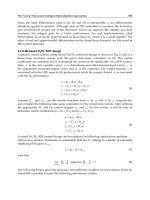Advances in PID Control Part 1 pot
Bạn đang xem bản rút gọn của tài liệu. Xem và tải ngay bản đầy đủ của tài liệu tại đây (495.64 KB, 20 trang )
ADVANCES IN
PID CONTROL
Edited by Valery D. Yurkevich
Advances in PID Control
Edited by Valery D. Yurkevich
Published by InTech
Janeza Trdine 9, 51000 Rijeka, Croatia
Copyright © 2011 InTech
All chapters are Open Access articles distributed under the Creative Commons
Non Commercial Share Alike Attribution 3.0 license, which permits to copy,
distribute, transmit, and adapt the work in any medium, so long as the original
work is properly cited. After this work has been published by InTech, authors
have the right to republish it, in whole or part, in any publication of which they
are the author, and to make other personal use of the work. Any republication,
referencing or personal use of the work must explicitly identify the original source.
Statements and opinions expressed in the chapters are these of the individual contributors
and not necessarily those of the editors or publisher. No responsibility is accepted
for the accuracy of information contained in the published articles. The publisher
assumes no responsibility for any damage or injury to persons or property arising out
of the use of any materials, instructions, methods or ideas contained in the book.
Publishing Process Manager Silvia Vlase
Technical Editor Teodora Smiljanic
Cover Designer Jan Hyrat
Image Copyright Bella D, 2010. Used under license from Shutterstock.com
First published August, 2011
Printed in Croatia
A free online edition of this book is available at www.intechopen.com
Additional hard copies can be obtained from
Advances in PID Control, Edited by Valery D. Yurkevich
p. cm.
ISBN 978-953-307-267-8
free online editions of InTech
Books and Journals can be found at
www.intechopen.com
Contents
Preface IX
Part 1 Advanced PID Control Techniques 1
Chapter 1 Predictive PID Control of Non-Minimum Phase Systems 3
Kenny Uren and George van Schoor
Chapter 2 Adaptive PID Control System Design
Based on ASPR Property of Systems 23
Ikuro Mizumoto and Zenta Iwai
Chapter 3 Analysis via Passivity Theory of a Class of
Nonlinear PID Global Regulators for Robot Manipulators 43
Jose Luis Meza, Víctor Santibáñez, Rogelio Soto,
Jose Perez and Joel Perez
Chapter 4 A PI
2
D Feedback Control Type for Second Order Systems 65
América Morales Díaz and Alejandro Rodríguez-Angeles
Chapter 5 From Basic to Advanced PI Controllers:
A Complexity vs. Performance Comparison 85
Aldo Balestrino, Andrea Caiti, Vincenzo Calabró,
Emanuele Crisostomi and Alberto Landi
Chapter 6 Adaptive Gain PID Control for Mechanical Systems 101
Ricardo Guerra, Salvador González and Roberto Reyes
Chapter 7 PI/PID Control for Nonlinear Systems
via Singular Perturbation Technique 113
Valery D. Yurkevich
Chapter 8 High-Speed and High-Precision Position
Control Using a Nonlinear Compensator 143
Kazuhiro Tsuruta, Kazuya Sato and Takashi Fujimoto
VI Contents
Chapter 9 PID Tuning: Robust and Intelligent
Multi-Objective Approaches 167
Hassan Bevrani and Hossein Bevrani
Part 2 Implementation and PID Control Applications 187
Chapter 10 Pole-Zero-Cancellation Technique for DC-DC Converter 189
Seiya Abe, Toshiyuki Zaitsu, Satoshi Obata,
Masahito Shoyama and Tamotsu Ninomiya
Chapter 11 Air-Conditioning PID Control System with
Adjustable Reset to Offset Thermal Loads Upsets 209
Takanori Yamazaki, Yuji Yamakawa,
Kazuyuki Kamimura and Shigeru Kurosu
Chapter 12 Remote-Tuning – Case Study of PI Controller
for the First-Order-Plus-Dead-Time Systems 229
Dennis Brandão, Nunzio Torrisi and Renato F. Fernandes Jr
Chapter 13 PID Application: RTLS 251
Jae Ho Hwang and Jae Moung Kim
Chapter 14 PID Controller Using FPGA Technology 259
Abdesselem Trimeche, Anis Sakly,
Abdelatif Mtibaa and Mohamed Benrejeb
Preface
Since the foundation and up to the current state-of-the-art in control engineering, the
problems of PID control steadily attract great attention of numerous researchers and
remain inexhaustible source of new ideas for process of control system design and
industrial applications. PID control effectiveness is usually caused by the nature of
dynamical processes, conditioned that the majority of the industrial dynamical
processes are well described by simple dynamic model of the first or second order. The
efficacy of PID controllers vastly falls in case of complicated dynamics, nonlinearities,
and varying parameters of the plant. This gives a pulse to further researches in the
field of PID control. Consequently, the problems of advanced PID control system
design methodologies, rules of adaptive PID control, self-tuning procedures, and
particularly robustness and transient performance for nonlinear systems, still remain
as the areas of the lively interests for many scientists and researchers at the present
time. The recent research results presented in this book provide new ideas for
improved performance of PID control applications.
The brief outline of the book "Advances in PID Control" is as follows.
In Chapter 1 the predictive control methods for non-minimum phase systems are
considered. In particular the classical approach is discussed where Smith predictor
and internal model control structures are used to derive the predictive PID control
constants. Then a modern approach to predictive PID control is treated and a
generalized predictive control algorithm is considered where the model predictive
controller is reduced to the same structure as a PID controller for second-order
systems.
In Chapter 2 an adaptive PID control system design approach based on the almost
strictly positive real (ASPR) property for linear continuous-time systems is presented.
It has been shown that the presented approach guarantees the asymptotic stability of
the resulting PID control system. In order to overcome the difficulties caused by
absence of ASPR conditions, a robust parallel feedforward compensator (PFC) design
method is proposed, which render the resulting augmented system with the PFC in
parallel ASPR system. As an example, the proposed method is applied to an
unsaturated highly accelerated stress test system.
X Preface
In Chapter 3 the authors discuss sufficient conditions for global asymptotic stability of
a class of nonlinear PID type controllers for rigid robot manipulators. By using a
passivity approach, the asymptotic stability analysis based on the energy shaping
methodology is presented for the systems composed by the feedback interconnection
of a state strictly passive system with a passive system. Simulation results are included
in the chapter and demonstrate that the proposed class of nonlinear PID type
controllers for rigid robot manipulators have good precision and also possess better
robustness. The performance of the proposed nonlinear PID type controllers has been
verified on a two degree of freedom direct drive robot arm.
In Chapter 4 some class of nonlinear second order systems is considered. The
proposed controller is a version of the classical PID controller, where an extra feedback
signal and integral term are added. The authors show based on simulation results for
simple pendulum and 2 DOF planar robot, that the proposed PI2D controller yields
better performance and convergence properties than the classical PID controller. The
stability analysis is provided via Lyapunov function method and conditions for gain
tuning are presented, which guarantee asymptotic convergence of the closed loop
system.
Chapter 5 is devoted to the comparison between the conventional PI controller tuned
according to Zhuang-Atherton rules with other PI-like controllers such as PI controller
with variable integral component, an adaptive PI controller, and a fuzzy adaptive PI
controller. The comparison and conclusions concern the control performance are made
by authors based on simulation results including simulations for a 3 DOF model of a
low-speed marine vessel.
In Chapter 6 an extension to the traditional PID controller for mechanical system has
been presented that incorporates an adaptive gain. The asymptotic stability of the
closed-loop system is analyzed based on Lyapunov function method. The tuning rules
for controller gains are derived.
In Chapter 7 an approach to continuous as well as digital PI/PID control system design
via singular perturbation technique is discussed that allows to guarantee the desired
output transient performances in the presence of nonlinear plant parameter variations
and unknown external disturbances. The tuning rules for controller parameters are
derived. Numerical examples with simulation results are included in the chapter to
demonstrate the efficacy of the proposed approach.
In Chapter 8 a new PID control method is proposed that includes a nonlinear
compensator. The algorithm of the nonlinear compensator is based on sliding mode
control with chattering compensation. The effect of the proposed control method is
evaluated for single-axis slide systems experimentally.
In Chapter 9 robust and intelligent multi-objective approaches are discussed for tuning
of PID controllers to improve the performance of the closed-loop systems where the
Preface XI
introduced tuning strategies are based on mixed H2/H-infty, multi-objective genetic
algorithm, fuzzy logic, and particle swarm optimization techniques.
In Chapter 10 the digitally controlled switch mode power supply is investigated based
on frequency domain approach where, in order to provide the desired frequency
characteristic, pole-zero-cancellation technique is used. The proposed control
technique is examined by using buck converter as a simple example.
In Chapter 11 the room temperature and humidity control systems with the
conventional PID control using fixed reset and the modified control using adjustable
resets which compensate for thermal loads upset are examined. The simulation results
for one-day operation are presented.
In Chapter 12 a tele-tuning architecture is described which is based on the
interconnection of the industrial plant, the server, and client. Identification tests were
performed to validate the proposed architecture by means of simulation of the first-
order-plus-dead-time systems using local and remote identification in a corporate
network.
In Chapter 13 a PID application in real-time locating system is described. It has been
shown that the proposed P-control and PID control algorithms require less calculation
and show robust performance in compare with the conventional direct calculation
method. The presented results can be used in embedded locating systems, home
networking systems and robotics positioning systems.
Chapter 14 is devoted to PID control implementation using field programmable gate
array technology. Experimental results for the second order system with P, PI, PD, and
PID controllers are presented.
This book is intended for researchers and engineers interested in PID control systems.
Graduate and undergraduate students in the area of control engineering can find in
the book new ideas for further research on PID control techniques. The editor would
like to thank all the authors for their contributions in the book. Finally, gratitude
should be expressed also to the team at InTech for the initiative and help in publishing
this book.
Prof. Valery D. Yurkevich
Novosibirsk State Technical University,
Russia
Part 1
Advanced PID Control Techniques
0
Predictive PID Control of Non-Minimum
Phase Systems
Kenny Uren and George van Schoor
North-West University, Potchefstroom Campus
South Africa
1. Introduction
Control engineers have been aware of non-minimum phase systems showing either
undershoot or time-delay characteristics for some considerable time (Linoya & Altpeter, 1962;
Mita & Yoshida, 1981; Vidyasagar, 1986; Waller & Nygardas, 1975). A number of researchers
that addressed this problem from a predictive control point of view mainly followed one
of two approaches: a classical (non-optimal) predictive approach or a modern optimisation
based predictive approach (Johnson & Moradi, 2005). The common characteristic of all these
approaches is that they are model-based. Predictive control allows the controller to predict
future changes in the output signal and to use this prediction to generate a desirable control
variable. The classical predictive controllers that are most widely considered include the
Smith predictor structure and the internal model control (IMC) structure (Katebi & Moradi,
2001; Morari & Zafiriou, 1989; Tan et al., 2001). Modern predictive controllers consider
generalised predictive control (GPC) or model-based predictive control (MPC) structures
(Johnson & Moradi, 2005; Miller et al., 1999; Moradi et al., 2001; Sato, 2010).
The performance of a PID controller degrades for plants exhibiting non-minimum phase
characteristics. In order for a PID controller to deal with non-minimum phase behaviour, some
kind of predictive control is required (Hägglund, 1992). Normally the derivative component
of the PID controller can be considered as a predictive mechanism, however this kind of
prediction is not appropriate when addressing non-minimum phase systems. In such a case
the PI control part is retained and the prediction is performed by an internal simulation of
plant inside the controller.
This chapter starts with a quick review of the system-theoretic concept of a pole and zero and
then draws the relationship to non-minimum phase behaviour. The relationship between the
undershoot response and time-delay response will be discussed using Padé approximations.
Classical and modern predictive PID control approaches are considered with accompanying
examples. The main contribution of the chapter is to illustrate the context and categories of
predictive PID control strategies applied to non-minimum phase systems by:
• Considering the history of predictive PID control;
• The use of models in predictive control design;
• Exploring recent advances in predictive PID control where GPC (Generalised Predictive
Control) algorithms play a prominent role;
1
2 PID Control
• Appreciating the control improvements achieved using predictive strategies.
2. The influence of poles and zeros on system dynamics
When considering the compensation of systems it is of great importance to first understand
the system-theoretic concept of a system pole and zero in the realm of system dynamics and
control theory. Consider a continuous-time single-input, single-output (SISO) system
˙
X
(t)=AX(t)+Bu(t), (1)
y
(t)=CX(t)+Du(t) , (2)
where u
(t) and y(t) are the scalar-valued input and output respectively. The column vector
X
(t) is called the state of the system and comprises n elements for an nth-order system. The
n
×n matrix A is called the system matrix and represents the dynamics of the system. The n ×
1 column vector B represents the effect of the actuator and the 1 ×n row vector C represents
the response of the sensor. D is a scalar value called the direct transmission term. If D
= 0, it
is assumed that the input u
(t) cannot affect the output y(t) directly.
If X
(0)=0 and D = 0 (in the case where the output is not directly influenced by the input),
then the system transfer function G
(s) is given by
G(s)=
Y(s)
U(s)
=
C(sI −A)
−1
B. (3)
The poles and zeros can be determined by writing G
(s) as
G(s)=
N(s)
D(s)
, (4)
where the numerator polynomial is
N
(s) det
sI
−A −B
C 0
, (5)
and the denominator polynomial is
D
(s) det(sI − A). (6)
Then the roots of N
(s) and D(s) are defined as the zeros and poles of G(s) respectively (Franklin
et al., 2010; Hag & Bernstein, 2007). This holds only in the case where N
(s) and D(s) do not
have common roots.
The poles of G
(s) can be used to determine damping and natural frequencies of the system, as
well as determining if the system is stable or unstable. As can be seen from Eq. (6) the poles
depend only on the system matrix A, but the zeros depend on matrices A, B and C. This leads
to the question as to how the zeros influence the dynamic response of a system?
Consider a normalised transfer function of a system with two complex poles and one zero
(Franklin et al., 2010):
T
(s)=
(
s/aζω
n
)+1
s
2
/ω
2
n
+ 2ζ(s/ω
n
)+1
. (7)
4
Advances in PID Control
Predictive PID Control of Non-Minimum
Phase Systems 3
The zero is therefore located at s = −aζω
n
. By replacing the s/ω
n
with s results in a frequency
normalising effect and also a time normalising effect in the corresponding step response.
Therefore the normalised version of Eq.(7) can be rewritten as
T
n
(s)=
s/aζ + 1
s
2
+ 2ζs + 1
. (8)
The normalised transfer function can be written as the sum of two terms
T
n
(s)=T
1
(s)+T
2
(s), (9)
=
1
s
2
+ 2ζs + 1
+
1
aζ
s
s
2
+ 2ζs + 1
, (10)
where T
1
(s) can be viewed as the original term with no added zeros, and T
2
(s) is introduced
by the zero. Since the Laplace transform of a derivative dy/dt is sY
(s), the step response of
T
n
(s) can be written as
y
n
(t)=y
1
(t)+y
2
(t)=y
1
(t)+
1
aζ
˙
y
1
(t) (11)
where y
1
and y
2
are the step responses of T
1
(s) and T
2
(s) respectively. The step responses for
the case when a
> 0 (introduction of a left half plane zero, a = 1.1, ζ = 0.5) are plotted in
Fig. 1(a). The derivative term y
2
introduced by the zero lifts up the total response of T
n
(s)
to produce increased overshoot. The step responses for the case when a < 0 (introduction of
a right half plane zero, a
= −1.1, ζ = 0.5) are plotted in Fig. 1(b). In this case the right half
plane zero, also called a non-minimum phase zero causes the response of T
n
(s) to produce an
initial undershoot.
In general a substantial amount of literature discusses the dynamic effects of poles, but less is
available on the dynamic effects of zeros.
3. A closer look at non-minimum phase zeros
Before a formal definition of non-minimum phase zeros can be given, some definitions and
assumptions are given. In this chapter only proper transfer functions will be considered. Eq.
(4) may be expanded so that
G
(s)=
N(s)
D(s)
=
b
m
s
m
+ b
m−1
s
m−1
+ ···+ b
1
s + b
0
s
n
+ a
n−1
s
n−1
+ ···+ a
1
s + a
0
. (12)
G
(s) is strictly proper if the order of the polynomial D(s) is greater than that of N(s) (i.e. n > m)
and exactly proper if n
= m (Kuo & Golnaraghi, 2010). If G(s) is asymptotically stable, that is,
when the roots of D
(s) are all in the left half plane, each zero has a specific effect on the system
for specific inputs. The roots of N
(s) (the zeros) can either be real or complex.
In general, a zero near a pole reduces the effect of that term in the total response. This can be
shown by assuming that the poles, p
i
, are real or complex but distinct and G(s) can be written
as a partial fraction expansion
G
(s)=
C
1
s − p
1
+
C
2
s − p
2
+ ···+
C
n
s − p
n
. (13)
5
Predictive PID Control of Non-Minimum Phase Systems
4 PID Control
0 5 10 15
−1
−0.5
0
0.5
1
1.5
Time [s]
Step response
Unit step input
y
n
(t)
y
1
(t)
y
2
(t)
(a) Effect of a left half plane zero
0 5 10 15
−1
−0.5
0
0.5
1
1.5
Time [s]
Step response
Unit step input
y
n
(t)
y
1
(t)
y
2
(t)
(b) Effect of a right half plane zero
Fig. 1. Step response of T
n
(s)
When considering Eq. (13), and the equation for the coefficient C
1
given by
C
1
=(s − p
1
)G(s)|
s=p
1
, (14)
it can be seen that in the case where G
(s) has an left half plane zero near the pole at s =
p
1
, the value of C
1
will decrease. This means that the coefficient C
1
, which determines the
contribution of the specific term in the response will be small. From this observation it can
also be said that in general, each zero in the left half plane blocks a specific input signal (Hag
& Bernstein, 2007). The question is what happens in the case of a right half plane zero?
(Hag & Bernstein, 2007) illustrated this by looking at the response of a transfer function to
an unbounded input signal such as u
(t)=e
t
. Fig. 2 shows the responses of two transfer
functions, G
1
(s)=2(s + 1)/(s + 1)(s + 2) and G
2
(s)=2(s −1)/(s + 1)(s + 2). It can be seen
that what distinguishes a right half plane zero is the fact that it blocked the unbounded signal.
With a better understanding of the character of right half plane zeros, a formal definition of a
non-minimum phase system will be given. Interesting enough, a non-minimum phase system
is defined as a system having either a zero or a pole in the right-half s-plane (Kuo & Golnaraghi,
2010). (Morari & Zafiriou, 1989) defined a non-minimum phase system as having a transfer
function that contains zeros in the right half plane or time delays or both.
6
Advances in PID Control
Predictive PID Control of Non-Minimum
Phase Systems 5
0 0.5 1 1.5 2 2.5 3 3.5 4 4.5 5
0
20
40
60
80
100
Time [s]
y
1
(t)
(a) Unbounded response of G
1
(s)
0 0.5 1 1.5 2 2.5 3 3.5 4 4.5 5
0
0.1
0.2
0.3
0.4
0.5
Time [s]
y
2
(t)
(b) Bounded response of G
2
(s)
Fig. 2. Responses due to an unbounded input signal u(t)=e
t
In this chapter the focus is on non-minimum phase systems showing either inverse response
(undershoot) or time-delays. Undershoot refers to an initial response in the opposite direction
from the steady state. According to (Bernardo & Leon de la Barra, 1994) continuous systems
having an odd number of real open right half plane zeros are characterised by an initial inverse
response to a step input.
Systems having a time-delay characteristic is a special case of non-minimum phase systems
(Waller & Nygardas, 1975). The Padé approximation is often used to approximate a time delay
by a rational transfer function. Consider a first-order system with time-delay given by
G
(s)=
K
1 + sτ
e
−sT
. (15)
K represents the gain constant, τ the time constant, and T the time-delay of the system. The
Padé approximation for the term e
−sT
is given by
e
−sT
∼
=
N
r
(sT )
D
r
(sT )
(16)
7
Predictive PID Control of Non-Minimum Phase Systems
6 PID Control
where
N
r
(sT )=
r
∑
k=0
(2r −k)!
k!(r − k)!
(−sT )
k
(17)
D
r
(sT )=
r
∑
k=0
(2r −k)!
k!(r − k)!
(sT )
k
(18)
and r is the order of the approximation (Silva et al., 2005).
Consider the function G
(s)=2e
−s
/(s + 1)(s + 2). The time-delay term can be approximated
by a first order Padé approximation given by
e
−s
∼
=
2T − s
2T + s
=
2 −s
2 + s
, (19)
and therefore the rational approximated version of G
(s) is given by
G
r
(s)=
2(−s + 2)
(s + 1)(s + 2)(s + 2)
. (20)
Fig. 3 plots the step responses of G and G
r
and it is interesting to note that the response of G
r
exhibits an initial inverse response. This also demonstrates a link between time delay-systems
and inverse response systems.
0 1 2 3 4 5 6 7 8 9 10
−0.2
0
0.2
0.4
0.6
0.8
1
1.2
Time [s]
Step response
Unit step input
Response of G(s)
Response of G
r
(s)
Fig. 3. First order Padé approximation of a time-delay system
4. Practical systems exhibiting non-minimum phase characteristics
Control engineers are often confronted with practical systems exhibiting an inverse response
or a time-delay. An inverse response is found in boiler level control systems. An inverse
response occurs when the flow rate of the feed water is increased by a step change, and the
total volume of boiling water decreases for a short period (Astrom & Hägglund, 1995; Linoya
& Altpeter, 1962). The same effect occurs in some aircraft regarding the step response of the
elevator deflection to pitch angle (Franklin et al., 2010). In some high temperature gas-cooled
reactors (HTGRs) such as the pebble bed modular reactor (PBMR) the power output also
shows undershoot phenomena when helium is injected at the low-pressure side of the power
conversion unit (PCU) (Uren et al., 2010).
8
Advances in PID Control









